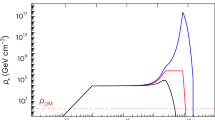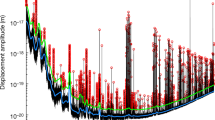Abstract
Light bosons, proposed as a possible solution to various problems in fundamental physics and cosmology1,2,3, include a broad class of candidates for physics beyond the standard model, such as dilatons and moduli4, wave dark matter5 and axion-like particles6. If light bosons exist in nature, they will spontaneously form ‘clouds’ by extracting rotational energy from rotating massive black holes through superradiance, a classical wave amplification process that has been studied for decades7,8. The superradiant growth of the cloud sets the geometry of the final black hole, and the black hole geometry determines the shape of the cloud9,10,11. Hence, both the black hole geometry and the cloud encode information about the light boson. For this reason, measurements of the gravitational field of the black hole/cloud system (as encoded in gravitational waves) are over-determined. We show that a single gravitational-wave measurement can be used to verify the existence of light bosons by model selection, rule out alternative explanations for the signal, and measure the boson mass. Such measurements can be done generically for bosons in the mass range [10−16.5, 10−14] eV using observations of extreme mass-ratio inspirals (EMRIs) by the forthcoming Laser Interferometer Space Antenna (LISA).
This is a preview of subscription content, access via your institution
Access options
Access Nature and 54 other Nature Portfolio journals
Get Nature+, our best-value online-access subscription
$29.99 / 30 days
cancel any time
Subscribe to this journal
Receive 12 digital issues and online access to articles
$119.00 per year
only $9.92 per issue
Buy this article
- Purchase on Springer Link
- Instant access to full article PDF
Prices may be subject to local taxes which are calculated during checkout


Similar content being viewed by others
Data availability
The data that supports the plots within this paper and other findings of this study are available from the corresponding author upon reasonable request.
References
Bertone, G., Hooper, D. & Silk, J. Particle dark matter: evidence, candidates and constraints. Phys. Rep. 405, 279–390 (2005).
Arvanitaki, A., Dimopoulos, S., Dubovsky, S., Kaloper, N. & March-Russell, J. String axiverse. Phys. Rev. D 81, 123530 (2010).
Marsh, D. J. E. Axion cosmology. Phys. Rep. 643, 1–79 (2016).
Arvanitaki, A., Huang, J. & Van Tilburg, K. Searching for dilaton dark matter with atomic clocks. Phys. Rev. D 91, 015015 (2015).
Schive, H.-Y., Chiueh, T. & Broadhurst, T. Cosmic structure as the quantum interference of a coherent dark wave. Nat. Phys. 10, 496–499 (2014).
Cardoso, V. et al. Constraining the mass of dark photons and axion-like particles through black-hole superradiance. J. Cosmol. Astropart. Phys. 1803, 043 (2018).
Zel’Dovich, Y. B. Generation of waves by a rotating body. J. Exp. Theor. Phys. Lett. 14, 180 (1971).
Press, W. H. & Teukolsky, S. A. Floating orbits, superradiant scattering and the black-hole bomb. Nature 238, 211–212 (1972).
Detweiler, S. L. Klein-Gordon equation and rotating black holes. Phys. Rev. D 22, 2323–2326 (1980).
Arvanitaki, A. & Dubovsky, S. Exploring the string axiverse with precision black hole physics. Phys. Rev. D 83, 044026 (2011).
Brito, R., Cardoso, V. & Pani, P. Black holes as particle detectors: evolution of superradiant instabilities. Class. Quant. Grav. 32, 134001 (2015).
Ferreira, M. C., Macedo, C. F. B. & Cardoso, V. Orbital fingerprints of ultralight scalar fields around black holes. Phys. Rev. D 96, 083017 (2017).
Dolan, S. R. Instability of the massive Klein−Gordon field on the Kerr spacetime. Phys. Rev. D 76, 084001 (2007).
Babak, S. et al. Science with the space-based interferometer LISA. V: Extreme mass-ratio inspirals. Phys. Rev. D 95, 103012 (2017).
Eda, K., Itoh, Y., Kuroyanagi, S. & Silk, J. New probe of dark-matter properties: gravitational waves from an intermediate-mass black hole embedded in a dark-matter minispike. Phys. Rev. Lett. 110, 221101 (2013).
LSC Algorithm Library (accessed 1 January 2018); https://wiki.ligo.org/Computing/DASWG/WebHome.
Arun, K. G., Buonanno, A., Faye, G. & Ochsner, E. Higher-order spin effects in the amplitude and phase of gravitational waveforms emitted by inspiraling compact binaries: ready-to-use gravitational waveforms. Phys. Rev. D 79, 104023 (2009).
Bohé, A., Marsat, S. & Blanchet, L. Next-to-next-to-leading order spin–orbit effects in the gravitational wave flux and orbital phasing of compact binaries. Class. Quant. Grav. 30, 135009 (2013).
Gair, J. R. et al. Event rate estimates for LISA extreme mass ratio capture sources. Class. Quant. Grav. 21, S1595–S1606 (2004).
Eda, K., Itoh, Y., Kuroyanagi, S. & Silk, J. Gravitational waves as a probe of dark matter minispikes. Phys. Rev. D 91, 044045 (2015).
Arvanitaki, A., Baryakhtar, M. & Huang, X. Discovering the QCD axion with black holes and gravitational waves. Phys. Rev. D 91, 084011 (2015).
Baumann, D., Chia, H. S. & Porto, R. A. Probing ultralight bosons with binary black holes. Preprint at https://arxiv.org/abs/1804.03208 (2018)..
Amaro-Seoane, P. Relativistic dynamics and extreme mass ratio inspirals. Living Rev. Relativ. 21, 4 (2018).
Nishizawa, A., Berti, E., Klein, A. & Sesana, A. eLISA eccentricity measurements as tracers of binary black hole formation. Phys. Rev. D 94, 064020 (2016).
Herdeiro, C. A. R. & Radu, E. Kerr black holes with scalar hair. Phys. Rev. Lett. 112, 221101 (2014).
Babak, S., Fang, H., Gair, J. R., Glampedakis, K. & Hughes, S. A. ‘Kludge’ gravitational waveforms for a test-body orbiting a Kerr black hole. Phys. Rev. D 75, 024005 (2007). Erratum: Phys. Rev. D 77, 04990 (2008).
Chua, A. J. K., Moore, C. J. & Gair, J. R. Augmented kludge waveforms for detecting extreme-mass-ratio inspirals. Phys. Rev. D 96, 044005 (2017).
Feroz, F. & Hobson, M. P. Multimodal nested sampling: an efficient and robust alternative to MCMC methods for astronomical data analysis. Mon. Not. R. Astron. Soc. 384, 449 (2008).
Feroz, F., Hobson, M. P. & Bridges, M. MultiNest: an efficient and robust Bayesian inference tool for cosmology and particle physics. Mon. Not. R. Astron. Soc. 398, 1601–1614 (2009).
Feroz, F., Hobson, M. P., Cameron, E. & Pettitt, A. N. Importance nested sampling and the MultiNest algorithm. Preprint at https://arxiv.org/abs/1306.2144 (2013)..
Robson, T., Cornish, N. & Liu, C. The construction and use of LISA sensitivity curves. https://arxiv.org/abs/1803.01944 (2018)..
Mikoczi, B., Vasuth, M. & Gergely, L. A. Self-interaction spin effects in inspiralling compact binaries. Phys. Rev. D 71, 124043 (2005).
Jaranowski, P., Krolak, A. & Schutz, B. F. Data analysis of gravitational-wave signals from spinning neutron stars. 1. The signal and its detection. Phys. Rev. D 58, 063001 (1998).
Allen, B., Anderson, W. G., Brady, P. R., Brown, D. A. & Creighton, J. D. E. FINDCHIRP: an algorithm for detection of gravitational waves from inspiraling compact binaries. Phys. Rev. D 85, 122006 (2012).
Berti, E., Buonanno, A. & Will, C. M. Estimating spinning binary parameters and testing alternative theories of gravity with LISA. Phys. Rev. D 71, 084025 (2005).
Vallisneri, M. Testing general relativity with gravitational waves: a reality check. Phys. Rev. D 86, 082001 (2012).
Maggiore, M. Gravitational Waves: Volume 1: Theory and Experiments (Oxford Univ. Press, Oxford, 2007)..
Gondolo, P. & Silk, J. Dark matter annihilation at the Galactic Center. Phys. Rev. Lett. 83, 1719–1722 (1999).
Acknowledgements
We thank C. Macedo, J. L. Rosa and G. Raposo for discussions on cloud depletion. O.A.H. is supported by the Hong Kong PhD Fellowship Scheme (HKPFS) issued by the Research Grants Council (RGC) of Hong Kong. E.B. and K.W.K.W. are supported by NSF grant no. PHY-1841464, NSF grant no. AST-1841358, NSF-XSEDE grant no. PHY-090003 and NASA ATP grant no. 17-ATP17-0225. R.B. acknowledges financial support from the European Union’s Horizon 2020 research and innovation programme under the Marie Skłodowska-Curie grant agreement no. 792862. This project has received funding from the European Union’s Horizon 2020 research and innovation programme under the Skłodowska-Curie grant agreement No. 690904. T.G.F.L. was partially supported by grants from the Research Grants Council of Hong Kong (project no. CUHK14310816 and CUHK24304317) and the Direct Grant for Research from the Research Committee of the Chinese University of Hong Kong. The authors acknowledge networking support by the GWverse COST Action CA16104, ‘Black holes, gravitational waves and fundamental physics’.
Author information
Authors and Affiliations
Contributions
O.A.H. conceived the idea of probing the existence of ultralight bosons, performed the full analysis, led the project and wrote the initial manuscript. K.W.K.W. surveyed the full LISA parameter space for the measurement and performed key analysis for the second figure. T.G.F.L. closely supervised all parts of the project, including its implementation and writing of the manuscript, and played an instrumental role in the development of the idea. E.B. made major revisions and contributions to the manuscript and provided theoretical input on superradiance and the overall study. R.B. provided detailed theoretical insight on superradiance and its coupling to gravitational waves, pointed out an error in the initial study that contributed to the final results and contributed significantly to the manuscript. All authors commented on the manuscript and wrote parts of it.
Corresponding author
Ethics declarations
Competing interests
The authors declare no competing interests.
Additional information
Publisher’s note: Springer Nature remains neutral with regard to jurisdictional claims in published maps and institutional affiliations.
Rights and permissions
About this article
Cite this article
Hannuksela, O.A., Wong, K.W.K., Brito, R. et al. Probing the existence of ultralight bosons with a single gravitational-wave measurement. Nat Astron 3, 447–451 (2019). https://doi.org/10.1038/s41550-019-0712-4
Received:
Accepted:
Published:
Issue Date:
DOI: https://doi.org/10.1038/s41550-019-0712-4
This article is cited by
-
Distinguishing environmental effects on binary black hole gravitational waveforms
Nature Astronomy (2023)
-
Astrophysics with the Laser Interferometer Space Antenna
Living Reviews in Relativity (2023)
-
Detecting fundamental fields with LISA observations of gravitational waves from extreme mass-ratio inspirals
Nature Astronomy (2022)
-
Probing dark matter spikes via gravitational waves of extreme-mass-ratio inspirals
Science China Physics, Mechanics & Astronomy (2022)
-
The effect of mission duration on LISA science objectives
General Relativity and Gravitation (2022)



